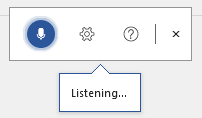You can currently dictate in English (UK and US), Chinese, French, German, Italian, and Spanish.
Speech tips
If you’ve already used a digital assistant such as Siri or Alexa, you’ve probably noticed that you get better results when speaking clearly.
The Office dictate tool is no different. If you speak clearly, pronounce your words correctly, and speak at a consistent pace, the dictate tool will understand you better. This is what we call 'dictational English.'
What if dictate makes errors?
No dictation software is currently foolproof, and dictate may make the odd mistake. It may also struggle with unusual words such as surnames.
A great way to proofread your dictated work in Microsoft Word is to use the read aloud feature.
Punctuation
You can say full stop and comma when you’ve finished your sentence or clause. When you want to start a new line, you can say new line.
Here’s a full list of punctuation phrases that you can use:
- Full stop
- Comma
- Question mark
- Exclamation mark
- New line
- Colon
- Semicolon
- Open quotes
- Close quotes
- Smiley face



